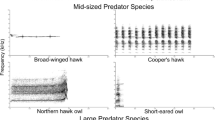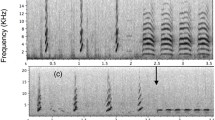Abstract
Avian predators vary in their degree-of-threat to chickadees; for example, smaller owls and hawks are of higher threat to chickadees as they can easily maneuver through the trees, while larger predators cannot. We conducted an operant go/no-go discrimination task to investigate the effect of signal degradation on perceived threat. Chickadees were trained to respond to high-threat northern saw-whet owl (NSWO) or low-threat great horned owl (GHOW) calls that were recorded at short distances, and then tested with high- and low-threat owl calls that were rebroadcast and re-recorded across six distances (25 m, 50 m, 75 m, 100 m, 150 m, and 200 m). Subjects were further tested with high-threat and low-threat synthetic tones produced to mimic the natural calls across the six distances. We predicted that birds would perceive and respond to: (1) high-threat predator calls at longer distances compared to low-threat predator calls, and (2) synthetic tones similarly compared to the stimuli that they were designed to mimic. We believed chickadees would continue to perceive and respond to predators that pose a high threat at further distances; however, only responding to low-threat stimuli was consistent across distance recordings. Synthetic tones were treated similarly to natural stimuli but at lower response levels. Thus, the results of this study provide insights into how chickadees perceive threat.




Similar content being viewed by others
References
Avey MT, Hoeschele M, Moscicki MK, Bloomfield LL, Sturdy CB (2011) Neural correlates of threat perception: neural equivalence of conspecific and heterospecific mobbing calls is learned. PLoS ONE 6:e23844
Baker MC, Becker AM (2002) Mobbing calls of black-capped chickadees: effects of urgency on call production. Wilson J Ornithol 114:510–517
Briggs DE (2015) The Cambrian explosion. Curr Biol 25:R864–R868
Chandler CR, Rose RK (1988) Comparative analysis of the effects of visual and auditory stimuli on avian mobbing behavior. J Field Ornithol 59:269–277
Congdon JV, Hahn AH, Filippi P, Campbell KA, Hoang J, Scully EN, Bowling DL, Reber SA, Sturdy CB (2019) Hear them roar: a comparison of black-capped chickadee (Poecile atricapillus) and human (Homo sapiens) perception of arousal in vocalizations across all classes of terrestrial vertebrates. J Comp Psychol. https://doi.org/10.1037/com0000187
Dudley R (2002) Mechanisms and implications of animal flight maneuverability. Integr Comp Biol 42:135–140
Griffiths R, Double MC, Orr K, Dawson RJ (1998) A DNA test to sex most birds. Mol Ecol 7:1071–1075
Hahn AH, Hoeschele M, Guillette LM, Hoang J, McMillan N, Congdon JV, Ratcliffe LM (2016) Black-capped chickadees categorize songs based on features that vary geographically. Anim Behav 112:93–104
Hahn AH, Campbell KA, Congdon JV, Hoang J, McMillan N, Scully EN, Sturdy CB (2017) Discrimination of acoustically similar conspecific and heterospecific vocalizations by black-capped chickadees (Poecile atricapillus). Anim Cogn 20:639–654
Hoang J (2015) Pitch perception is not unitary: evidence for the perception of pitch chroma in black-capped chickadees (Unpublished master’s thesis). University of Alberta, Edmonton
Kryštofková M, Haas M, Exnerová A (2011) Nest defense in blackbirds Turdus merula: effect of predator distance and parental sex. Acta Ornithol 46:53–61
Lima SL, Dill LM (1990) Behavioral decisions made under the risk of predation: a review and prospectus. Can J Zool 68:619–640
Martin JP, Doucet SM, Knox RC, Mennill DJ (2011) Body size correlates negatively with the frequency of distress calls and songs of neotropical birds. J Field Ornithol 82:259–268
Njegovan M, Hilhorst B, Ferguson S, Weisman R (1994) A motor-driven feeder for operant training in song birds. Behav Res Methods Instrum Comput 26:26–27
Palya WL, Walter DE (2001) Document set for the high-performance experiment controller. https://www.jsu.edu/depart/psychology/sebac/Exp-Ctl.html. Accessed 25 Oct 2014
Proppe DS, Bloomfield LL, Sturdy CB (2010) Acoustic transmission of the chick-a-dee call of the black-capped chickadee (Poecile atricapillus): forest structure and note function. Can J Zool 88:788–794
Pyke GH, Pulliam HR, Charnov EL (1977) Optimal foraging: a selective review of theory and tests. Q Rev Biol 52:137–154
Pyle P (1997) Identification guide to North American birds. Slate Creek Press, Bolinas
Smith SM (1991) The black-capped chickadee: behavioral ecology and the natural history. Cornell University Press, Ithaca
Sturdy CB, Weisman RG (2006) Rationale and methodology for testing auditory cognition in songbirds. Behav Proc 72:265–272
Templeton CN, Greene E (2007) Nuthatches eavesdrop on variations in heterospecific chickadee mobbing alarm calls. Proc Natl Acad Sci 104:5479–5482
Templeton CN, Greene E, Davis K (2005) Allometry of alarm calls: black-capped chickadees encode information about predator size. Science 308:1934–1937
Yip DA, Bayne EM, Sólymos P, Campbell J, Proppe D (2017) Sound attenuation in forest and roadside environments: implications for avian point-count surveys. Condor Ornithol Appl 119:73–84
Acknowledgements
All animal studies were conducted in accordance with the Canadian Council on Animal Care Guidelines and Policies and with approval from the Animal Care and Use Committee for Biosciences for the University of Alberta, and the University of Calgary Life and Environmental Sciences Animal Care Committee. Chickadees were captured and research was carried out under an Environment Canada Canadian Wildlife Service Scientific permit, Alberta Fish and Wildlife Capture and Research permits, and City of Edmonton Parks Permit. This research was supported by a Natural Sciences and Engineering Research Council of Canada (NSERC) (Grant nos. 249884, 412311) Discovery Grant and Discovery Accelerator Supplement, an Alberta Ingenuity Fund (AIF) New Faculty Grant, a Canada Foundation for Innovation (CFI) New Opportunities Fund (NOF) and Infrastructure Operating Fund (IOF) grants along with start-up funding and CFI partner funding from the University of Alberta (UofA) to CBS. JVC and KAC were each supported by an Alexander Graham Bell Canada Graduate Scholarship-Doctoral (NSERC CGS D). We would like to thank the undergraduate students that supervised our operant chambers throughout the length of the experiment: Erica Cheung (Research Assistant), Alyshia Skurdal (Undergraduate Research Stipend), and Brenna Schuldhaus (NSERC Undergraduate Student Research Award).
Author information
Authors and Affiliations
Corresponding author
Additional information
Publisher's Note
Springer Nature remains neutral with regard to jurisdictional claims in published maps and institutional affiliations.
Rights and permissions
About this article
Cite this article
Congdon, J.V., Hahn, A.H., Campbell, K.A. et al. Can you hear me now? The effect of signal degradation on perceived predator threat in black-capped chickadees (Poecile atricapillus). Anim Cogn 24, 193–204 (2021). https://doi.org/10.1007/s10071-020-01433-9
Received:
Revised:
Accepted:
Published:
Issue Date:
DOI: https://doi.org/10.1007/s10071-020-01433-9




